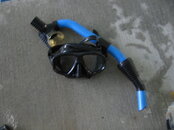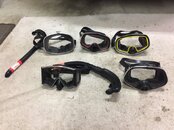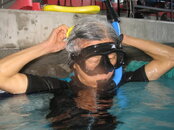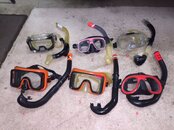Yes, yes we did.but oh well people got what I meant.
You are using an out of date browser. It may not display this or other websites correctly.
You should upgrade or use an alternative browser.
You should upgrade or use an alternative browser.
Snorkel cracking pressure?
- Thread starter jdevic
- Start date
Please register or login
Welcome to ScubaBoard, the world's largest scuba diving community. Registration is not required to read the forums, but we encourage you to join. Joining has its benefits and enables you to participate in the discussions.
Benefits of registering include
- Ability to post and comment on topics and discussions.
- A Free photo gallery to share your dive photos with the world.
- You can make this box go away
CT-Rich
Contributor
The muscles in your chest are pushing against the surrounding water. The air is being drawn in at sea level pressure. You are also drawing air down a pipe. As it passes through the snorkel, the inside surface of the snorkel will create turbulence and resistance that will take effort to overcome. If it has a device to keep the water out, just more crap to disrupt the flow of air....
Hi Bob,
I'll give a short answer here, then probably expand on it in a subsequent post.
Snorkels are quite different from a regulator second stage (single hos regulator). The original J-shaped snorkel had breathing resistance related to its length and diameter. The shorter, and larger in diameter, the less the breathing resistance. I once completed a 18 mile finswim in open epwater with a Scubapro Shotgun snorkel I cut off at the top of my head. In comparison, an outstanding-performing second stage has a cracking pressure of somewhere around 0.5-1 inch of water pressure, and the effort then goes downd due to the Venturi effect. Snorkels have no Venturi. So that's a major difference. If anything is placed on the end of a snorkel, to redirect wave water out of the snorkel or close it, the breathing resistance in most cases increases. "Dry" snorkels or worst for breathing resistance (with about two exceptions).
John
What are the exceptions?... "Dry" snorkels or worst for breathing resistance (with about two exceptions).
John
The two major exceptions are the Aqualung Impulse III and the Scubapro Shotgun 2 Twin Valve (which may be out of production. Each of these snorkels uses a different principle to carry water out of the snorkel from wave action, and are very easy to clear. They also do not restrict air flow through the snorkel. I have photos of the Aqualung Impulse snorkel, which we bought in the 1990s and still use (my wife has claimed both) and my Shotgun snorkel (on the Dacor Tri-view mask nearest the camera). My wife, Chris is using the blue Impulse snorkel. The Impulse III is the latest model, and the bulb on top is more streamlined than the original Impulse. In Maui, Hawaii, one snorkel tour company uses the Impulse III exclusively. The Scubapro Shotgun 2 Twin Valveis shown on the back row on the left, along with the Scubapro 3 window mask. I used my Scubapro Shotgun 2 Twin Valve today in the pool, and Chris used her Impulse snorkel today too.What are the exceptions?
I have made a lot of comments on masks and snorkels here:
http://vintagescuba.proboards.com/thread/3538/odd-masks?page=2&scrollTo=45806
SeaRat
Attachments
dmaziuk
Contributor
I suppose an S-shaped snorkel with the ball hanging in a cage below the hole shouldn't restrict airflow. I wonder if anyone makes those; there's plenty over in "vintage" threads.
No, the turns themselves will set up more resistance, and I've actually sucked the ping pong ball back into the cage, stopping air flow (that was when Iwas about twelve years old in 1957, and I cut the upper portion of the snorkel tube off to make it a J-snorkel).I suppose an S-shaped snorkel with the ball hanging in a cage below the hole shouldn't restrict airflow. I wonder if anyone makes those; there's plenty over in "vintage" threads.
SeaRat
Well, you made me look. I don't know the Scubapro item, but the Aqualung Impuse 3 is a semi-dry snorkel, and is NOT a dry snorkel.The two major exceptions are the Aqualung Impulse III and the Scubapro Shotgun 2 Twin Valve (which may be out of production. Each of these snorkels uses a different principle to carry water out of the snorkel from wave action, and are very easy to clear. They also do not impart air flow through the snorkel. I have photos of the Aqualung Impulse snorkel, which we bought in the 1990s and still use (my wife has claimed both) and my Shotgun snorkel (on the Dacor Tri-view mask nearest the camera). My wife, Chris is using the blue Impulse snorkel. The Impulse III is the latest model, and the bulb on top is more streamlined than the original Impulse. In Maui, Hawaii, one snorkel tour company uses the Impulse III exclusively. The Scubapro Shotgun 2 Twin Valveis shown on the back row on the left, along with the Scubapro 3 window mask. I used my Scubapro Shotgun 2 Twin Valve today in the pool, and Chris used her Impulse snorkel today too.
SeaRat
There is no ball or flapper to seal the tube, and if you dive down to explore the tube will fill with water, unlike a dry snorkel that has a mechanism to close the top of the tube when submerged.
Aqualung still makes an Impulse 2 which is closer to your photos, and also makes an Impulse Dry, which has a flapper mechanism. Their one unique aspect on the Impulse Dry is that they faced the mechanism forward instead of to the side, so that it seals a little sooner when you dive down.
BTW: I use an Impulse 3, and it does breathe very well, although a little top heavy when I am at the surface briefing/chatting.
I bought the Aqualung dry snorkel you describe, and got it because it has a GoPro attachment on the bottom of the snorkel. I took it into the river last summer with my GoPro attached, and it was fine as long as I stayed on the surface. Then I surface dived down to anpbout 23 feet, and as I got to the bottom the snorkel tried to suck my tongue out into the tube--I didn't like that, and spit out the snorkel while on the bottom. That messed up the video a bit.Well, you made me look. I don't know the Scubapro item, but the Aqualung Impuse 3 is a semi-dry snorkel, and is NOT a dry snorkel.
There is no ball or flapper to seal the tube, and if you dive down to explore the tube will fill with water, unlike a dry snorkel that has a mechanism to close the top of the tube when submerged.
Aqualung still makes an Impulse 2 which is closer to your photos, and also makes an Impulse Dry, which has a flapper mechanism. Their one unique aspect on the Impulse Dry is that they faced the mechanism forward instead of to the side, so that it seals a little sooner when you dive down.
When you completely seal the snorkel, the tube is then exposed to the same treasure differentials as any closed system, and it there is an opening, it tries to fill it to equalize the pressure. So you can say that there is now a thing called a "Snorkel Squeeze" because of these dry snorkels.
I took this snorkel home, heated it with hot water, and took the top off. I then evaluated it without the top, and found that the non-return is not as well-designed as their Impulse snorkel, and leaves some water in the bottom when cleared. I removed it b y closing the top and blowing, which is a good way to clear these snorkels of small amounts of water. Please look at the VSS website link above for more comments on many different snorkels.
John
Your windpipe is only about 25mm wide or a bit less than an inch. Friction of the air in the snorkel tube only matters if you're breathing really, really hard through it. Snorkels are great for looking at stuff before you dive down to have a closer look. Many freedivers, breathe really hard with the snorkel out of their mouths (or not even there) before they dive and don't return to the snorkel until their breathing is back to normal.
Similar threads
- Replies
- 32
- Views
- 9,389
- Replies
- 20
- Views
- 2,167
- Replies
- 4
- Views
- 750
- Replies
- 2
- Views
- 381







